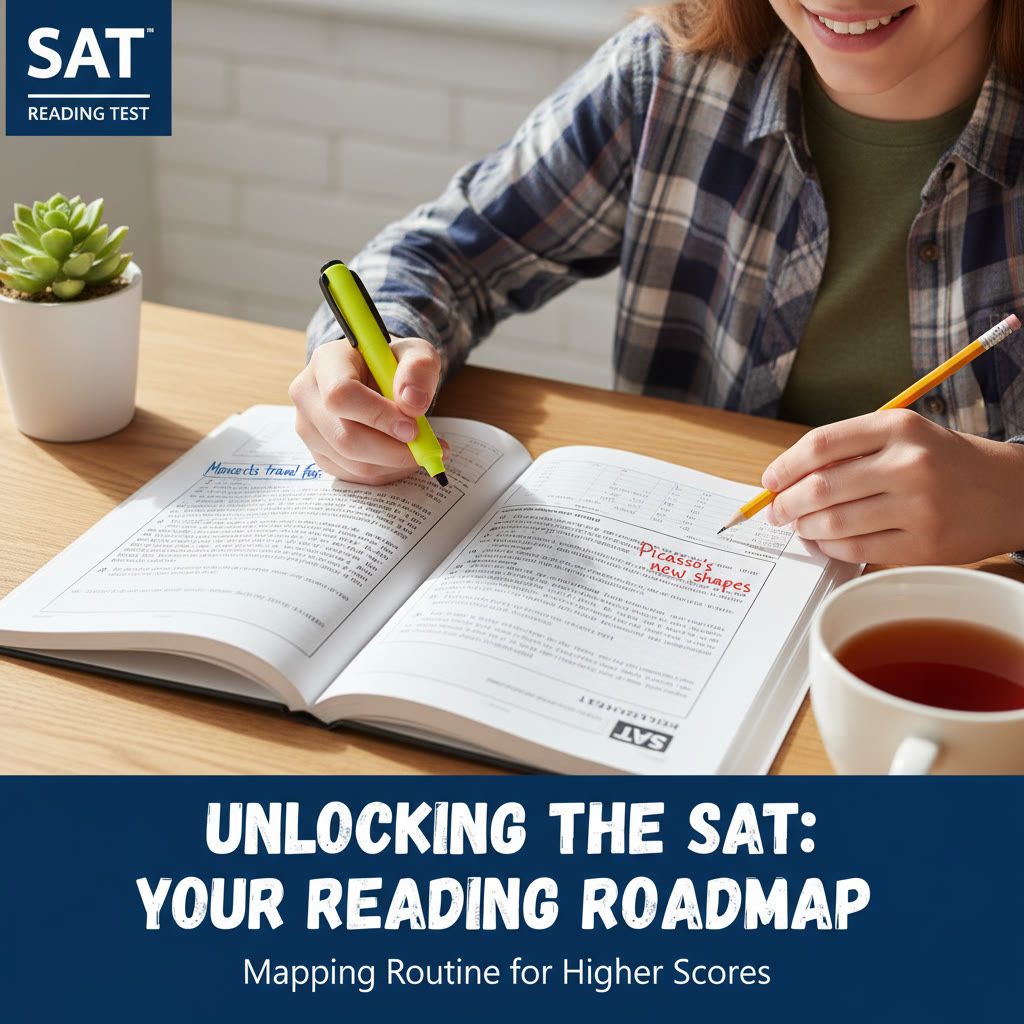Why Paired Reading Questions Feel Like a Trap
There’s a particular kind of dread that hits when you flip from one passage to its paired partner on the SAT. The first passage might be a calm, measured description; the second, a sharp critique. The timer keeps ticking, and suddenly the test asks you to compare the two authors’ tones, or to identify which passage provides evidence for a specific claim. You reread. You second-guess. You pick an answer that feels right but is wrong. Sound familiar?
Paired reading questions aren’t designed to be mean — they test skills that matter: synthesis, comparison, and precision with evidence. But because these tasks require juggling two texts and often reconciling subtle differences in wording, students who haven’t trained for that juggling act will trip up. This post pulls that feeling apart: we’ll look at exactly what makes paired passages tricky, the most common mistakes students make, concrete strategies you can use immediately, a worked example, and a realistic practice plan to build confidence.
The anatomy of a paired passage set
Understanding the structure is the first step to mastering it. Paired passages typically contain two short essays or excerpts that are connected thematically — they might argue opposing viewpoints, approach a similar subject from different disciplines (a literary treatment vs. a historical or scientific one), or present the same event from different perspectives. Questions ask you not only about each passage individually but also about their relationship.
What the SAT expects you to do
- Comprehend each passage’s main idea and structure.
- Identify the author’s purpose and tone for each passage.
- Locate and interpret evidence in context — sometimes across both passages.
- Synthesize information: compare, contrast, or evaluate how the passages interact.
- Choose precise answers supported by the text, not by outside knowledge or assumptions.
Why students struggle: the usual suspects
Let’s break down the reasons students stumble. Each entry includes a short explanation so you can spot the pattern when it happens to you.
- Information overload: Two passages double the content. Under time pressure, that can feel overwhelming and invite skimming where careful reading is required.
- Surface-level reading: Students sometimes skim for keywords but miss the author’s stance or subtle qualifiers like “however,” “yet,” or “in contrast.” Those small words often carry the relationship between passages.
- Pronoun confusion: When questions ask about “the author” or “they,” it can be unclear which passage or which sentence the test means unless you track references carefully.
- Assuming equivalence: Just because two passages discuss the same topic doesn’t mean they agree — assuming agreement leads to incorrect comparative answers.
- Evidence errors: Choosing answers that sound plausible but aren’t directly supported by the text is a classic mistake.
- Time mismanagement: Paired passages demand a little more time; misallocating it can leave you rushed and careless.
- Vocabulary temptations: Focusing too much on an unfamiliar word rather than the sentence or paragraph context leads to misinterpretation.
Common mistakes — a compact reference
Here’s a diagnostic table showing what often goes wrong and how to fix it. Use it as a checklist after you miss a question to turn mistakes into learning opportunities.
| Common mistake | What it looks like | How to fix it |
|---|---|---|
| Choosing the plausible but unsupported answer | Answer sounds reasonable but the passage doesn’t say it explicitly. | Underline the exact phrase in the text that supports your answer. If you can’t find it, eliminate that option. |
| Mixing up passage references | Answer refers to the wrong author or paragraph. | Label passages “A” and “B” in the margin and note the author’s main stance in 2-3 words. |
| Overreliance on outside knowledge | Bringing in facts not in the passages to support an answer. | Answer from the text only; pretend you don’t know the topic beyond the excerpts. |
| Rushed synthesis | Failing to map the relationship between passages before answering comparative questions. | Spend 30–45 seconds to jot the relationship (agree, disagree, nuance) before tackling comparative items. |
Practical strategies: before the test and during the test
Preparation (weeks before test day)
- Practice paired passages deliberately: Don’t treat them like single passages; work through only paired sets for focused training. Time yourself and review every miss.
- Build a comparison toolkit: Practice identifying author stance, tone, evidence, and structure quickly. Create a two-column note template to use during practice: left for Passage A key points, right for Passage B key points.
- Train with varied genres: Paired passages can pair a scientific report with an editorial, or a short story excerpt with a critical analysis. Exposure to different styles reduces surprise on test day.
- Get targeted feedback: Work with a tutor or teacher who can explain patterns in your errors. Sparkl’s personalized tutoring can be a great fit here — 1-on-1 guidance, tailored study plans, expert tutors, and AI-driven insights help pinpoint whether you’re losing points to time, misreading, or evidence errors.
On test day: a 3-step routine for paired passages
- Step 1 — Quick mapping (30–45 seconds): After a calm read-through of Passage A, write two short notes for each passage: main idea (4–8 words) and author’s stance/tone (2–4 words). Do the same for Passage B. This gives you an anchor during comparative questions.
- Step 2 — Question triage: Tackle passage-specific questions right after reading that passage if they appear; save cross-passage questions for after you’ve mapped both. If timing is tight, answer easy questions first to lock in points.
- Step 3 — Evidence check: For each answer, find the exact sentence or phrase that justifies it. If you can’t find that snippet, re-evaluate the choice. SAT answers are about what the text supports, not what it implies in your head.
A worked example: short passages and a question walkthrough
Below are two short, condensed excerpts purposefully simplified so we can walk through the reasoning without getting lost in length. Treat these like SAT-style paired passages: read, map, then answer the comparative question.
Passage A (excerpt)
In recent years, urban gardening has been celebrated as a civic good: it reclaims neglected lots, fosters community, and puts fresh produce in food deserts. While critics argue that such projects are small-scale and insufficient for systemic food issues, gardeners reply that incremental change builds habits and networks that scales larger efforts.
Passage B (excerpt)
Urban gardening is often romanticized. Observers note that logistical challenges — soil contamination, inconsistent funding, and zoning laws — limit impact. Rather than focusing on grassroots plots, a policy-driven approach that secures funding and reforms land-use laws could produce more reliable benefits.
Sample question (paraphrased like the SAT)
Which choice best describes how the two passages differ in their approach to the problem of food access in cities?
- A. Passage A emphasizes small-scale community action while Passage B emphasizes systemic policy change.
- B. Passage A claims urban gardening can fully solve food deserts; Passage B claims food deserts are unsolvable.
- C. Passage A focuses on economic analysis; Passage B focuses on cultural benefits.
- D. Passage A and Passage B both agree that urban gardening is a sufficient long-term solution.
Walkthrough
Step 1 — Map quickly.
- Passage A: main idea = benefits of urban gardening; stance = supportive but acknowledging limits (incrementalism).
- Passage B: main idea = practical limits of urban gardening; stance = favors policy solutions.
Step 2 — Evaluate the choices against the text.
- A: Matches our mapping — A favors small-scale/community action, B favors systemic policy change. Supported.
- B: Passage A does not claim gardening can fully solve food deserts; it says critics call it small-scale and that gardeners see it as incremental. Passage B does not claim food deserts are unsolvable. So B is wrong.
- C: Neither passage focuses primarily on economic analysis vs. cultural benefits; C mislabels both.
- D: The passages disagree; D is wrong.
Answer: A. Notice the process: mapping, locating the explicit stances, and rejecting options that overstate the passages’ claims. This is the difference between a confident answer and an appealing-but-incorrect guess.
Drills and habits that actually improve your score
Practice with intention. Here are drills to make your reading sharper and faster.
- Two-column summaries: For each paired passage you practice, write one sentence summarizing Passage A and one summarizing Passage B. Then write a single sentence that explains their relationship (agree, disagree, nuance).
- Evidence retrieval drill: Time yourself finding the sentence that supports a specific claim. Build speed by aiming for under 20 seconds for single-sentence evidence and under 45 seconds for cross-passage evidence.
- Tonedown vocabulary isolation: When you hit a tricky word, write a one-line paraphrase of the entire sentence in simpler words instead of stopping to define the word in isolation.
- Question-type practice: Group practice by question types: main idea, tone, evidence, function, and comparative. Master one type and move to the next.
How to spend practice time efficiently
Quality beats quantity. A 6-week plan with consistent, focused drills is more effective than cramming. Here’s a sample schedule you could follow in the month or six weeks before your SAT:
| Week | Focus | Weekly routine (3 sessions/week) |
|---|---|---|
| 1 | Familiarization | Session 1: Read 4 paired passages slowly and map. Session 2: Summarize & answer with evidence. Session 3: Review mistakes and note patterns. |
| 2 | Speed + accuracy | Session 1: Timed practice on 3 paired sets. Session 2: Evidence retrieval drill. Session 3: Target missed question types. |
| 3 | Comparative nuance | Session 1: Focus on tone and purpose questions. Session 2: Work cross-passage evidence. Session 3: Full diagnostic set. |
| 4+ | Polish & simulation | Session 1: Full sections under timed conditions. Session 2: Review every wrong answer. Session 3: Light review and rest. |
When targeted help is the fastest route to improvement
If you’ve been practicing and feel stuck — maybe you’re consistently missing evidence-based questions or running out of time — personalized help speeds progress. One-on-one tutoring allows a teacher to diagnose patterns in your mistakes and tailor drills to those weak spots. Sparkl’s personalized tutoring offers precisely this: 1-on-1 guidance, tailored study plans, expert tutors, and AI-driven insights that analyze which question types drain your score. That mix of human feedback and data-driven focus helps many students turn repeated mistakes into reliable strategies.
Mindset and small rituals that save points on test day
Beyond tactics and drills, a few mental habits make a big difference when pressure mounts.
- Name the passages: Literally write “A: [two words]” and “B: [two words]” in the margin. It reduces confusion later.
- Breathe and pace: If a comparative question feels murky, take one slow breath, reread the question carefully, and return to your two-sentence map before answering.
- Trust the text: The SAT rewards text-based evidence. If an answer depends on outside knowledge, eliminate it.
- Accept ambiguity when it’s there: Some choices will seem close. The SAT’s correct answer is the one most directly supported by the passages — not the one you wish were true.
Final checklist before you walk into test day
- Have you practiced paired passages under timed conditions? Yes/no — if no, add this to your plan now.
- Do you use a quick mapping routine (30–45 seconds) for each paired set? If not, try it during your next practice.
- Do you always label passages A/B and note the stance in a few words? If not, start today.
- Have you reviewed common traps: plausible-but-unsupported answers, mixed references, and outside knowledge? If not, review the table above.
Parting thought
Paired reading questions are challenging because they ask you to do more than understand a single text; they ask you to compare, synthesize, and be precise under time pressure. But those are skills — and skills improve with the right kind of practice. Use two-column mappings, evidence-first answering, and targeted drills to train your brain to think like the SAT does: text-first, precise, and efficient. If you ever feel stuck, remember that focused 1-on-1 help (like Sparkl’s personalized tutoring with tailored study plans and AI-driven insights) can shorten your learning curve. With steady work, paired passages will stop feeling like a trap and start feeling like another kind of puzzle you’re ready to solve.



















No Comments
Leave a comment Cancel